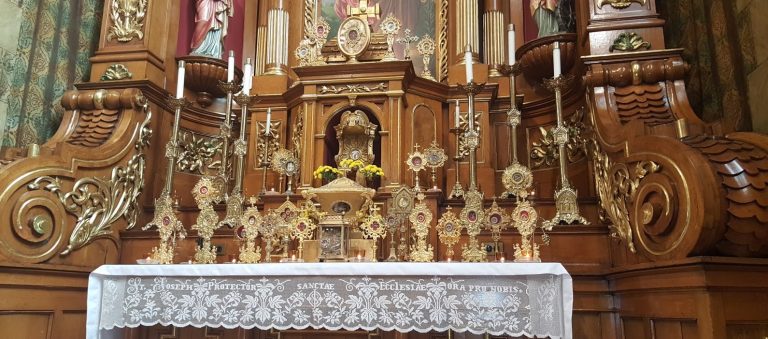[fbshare type=”button” float=”right” width=”100″] By David Fagerberg

Two years ago I committed one of the more heroic acts in my life. I drove in Italy. To locate my valor more precisely, I drove through Pisa to take my family to see “The Leaning Tower Of.” Until that trip, my wife and children did not know my head could rotate so nimbly, or that a Fiat Punto could downshift from fourth to first gear at that rpm, or that the laws of physics could be flexed slightly in the cause of fitting in a parking space. Neither did I. So after ogling the sights, we rushed out of Pisa to avoid its real rush hour traffic, and retreated to our haven in Siena run by the Dominican sisters.
Thus it was that I did not discover until it was too late—for nothing would induce me to a repeat automotive encounter with Pisa—that in our haste we had missed a remarkable sight. It is one I imagine many visitors overlooking if they are, as we were, distracted by the magnificent cathedral and baptistery and leaning bell tower. The university, I read in the guidebook, has one of Galileo’s fingers.
At first the fact did not startle me, because after a week in Europe and visits to a number of churches, we had seen more bones than we do in America (in Minnesota, anyway). We had been to the Capuchin chapel in Rome ornamented with thousands of bones from their disrupted cemetery; we had worshiped in proximity with the bones of assorted bishops in numerous cathedrals; and on the hill above our hotel room in Siena, exposed in a side chapel of San Domenico, was the head of that city’s most famous daughter, Catherine.
But after a day or two, a theological divergence between the case of Galileo and Catherine began to appear in my mind. I could not keep from wondering how Galileo’s finger was being preserved? Catherine’s head was in a shrine, behind an altar. But since Galileo had been a university man, and his finger was at a university, I couldn’t keep from remembering the formaldehyde jars in high school biology class that contained specimens of mice and jellyfish and baby rabbits. And the guide book made no mention of where the other nine fingers were to be found. Zealous medieval pilgrims sometimes stole relics; had Galileo’s other fingers been translated to universities around the country by heliocentric devotees? And which finger was it? Possibly one capable of making a rude gesture at the inquisitors who had imprisoned him?
Most of all, I wondered what one could do with the finger of Galileo? Fingers usually point to things. Perhaps the finger was pointing to the sun as center of the universe, or to one of the four moons of Jupiter he discovered, or to a trenchant point in the theory of isochronism that he hypothesized at age nineteen. Fingers point, and whatever his bony finger was now pointing at, I was pretty sure it was still some part of the natural world that he had poked and prodded while he lived. On the other hand, what could one do with Catherine’s head? Faces look, and sometimes when you look into a face you can see what the person is looking at. That’s why although the Pope kept her body at Rome, he capitulated to a posthumous beheading so that Siena, and all pilgrims—medieval or modern—could look into her face once more. And I was pretty sure that Catherine was still looking at the supernatural world into which she had gazed while she lived.
Chesterton said, “The saint is a medicine because he is an antidote. Indeed that is why the saint is often a martyr; he is mistaken for a poison because he is an antidote. He will generally be found restoring the world to sanity by exaggerating whatever the world neglects, which is by no means always the same element in every age. Yet each generation seeks its saint by instinct; and he is not what the people want, but rather what the people need . . . Therefore it is the paradox of history that each generation is converted by the saint who contradicts it most.”
Galileo pointed out some marvels of this creation, but I’m not sure if they are as therapeutic to me as a woman who dialogued with God. Even if Galileo pointed to the highest heaven, a heaven beyond the range of his telescopes and ours, Catherine looked at something still higher, and pilgrims can see it in her face. Chesterton said it is the poet who asks to get his head into the heavens; it is the logician (and, I add, the scientist) who seeks to get the heavens into his head, and it is the latter’s head that splits. Galileo had his finger trained on the sun to chart its course across the sky and prove we went round it, but Catherine turned her face to map our course to a yet higher reality.
I do not say that Galileo’s accomplishments are unimportant; I only say that I would not risk Pisa’s traffic for anything he could point to, while I would join with other pilgrims in risking anything for that with which Catherine had come face to face. That’s why we save her bones.
David Fagerberg is associate professor of theology at the University of Notre Dame, director of the Notre Dame Center for Liturgy, and editor of its publication Assembly. He is the author of several books, including Chesterton is Everywhere, available from Emmaus Road Publishing.